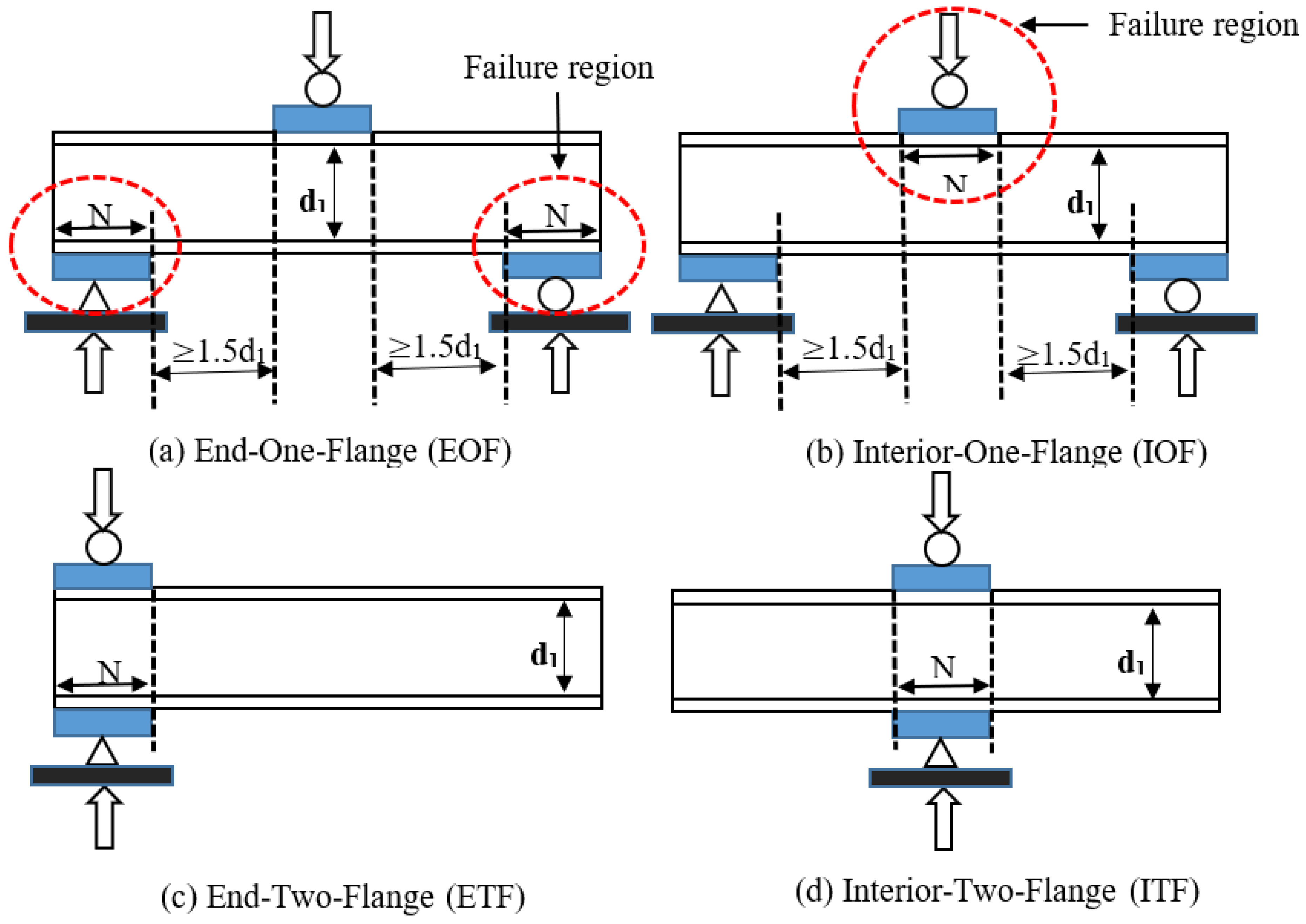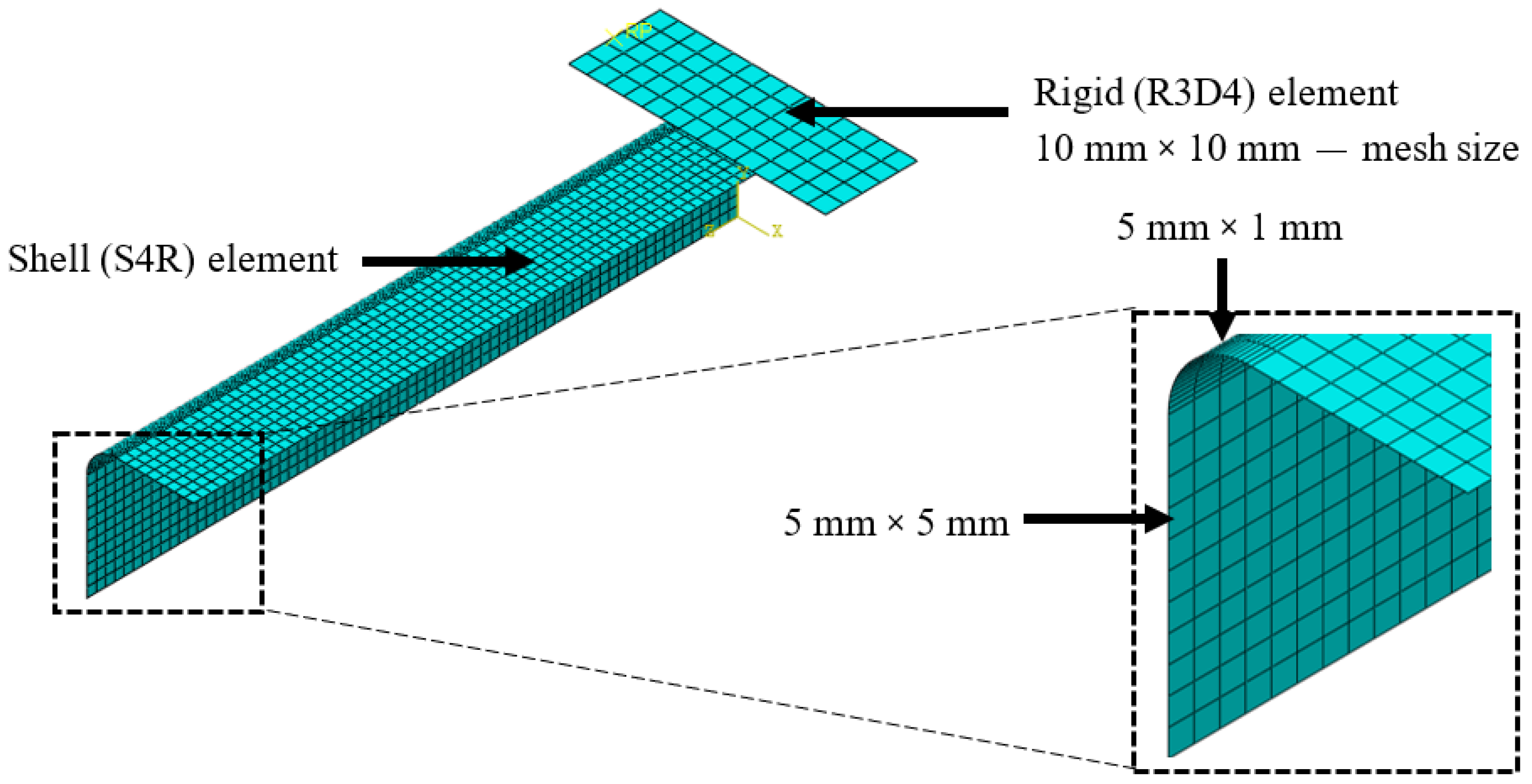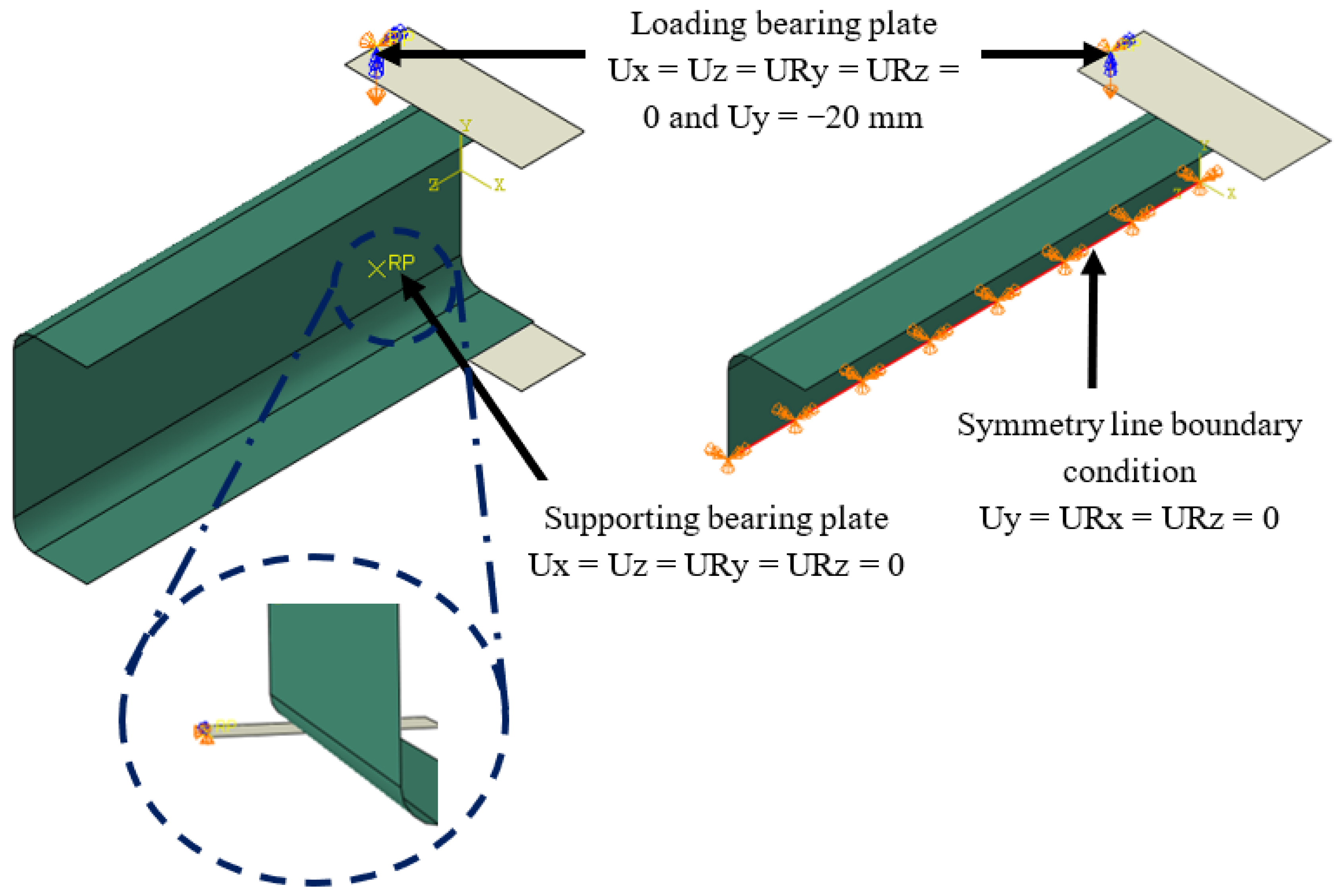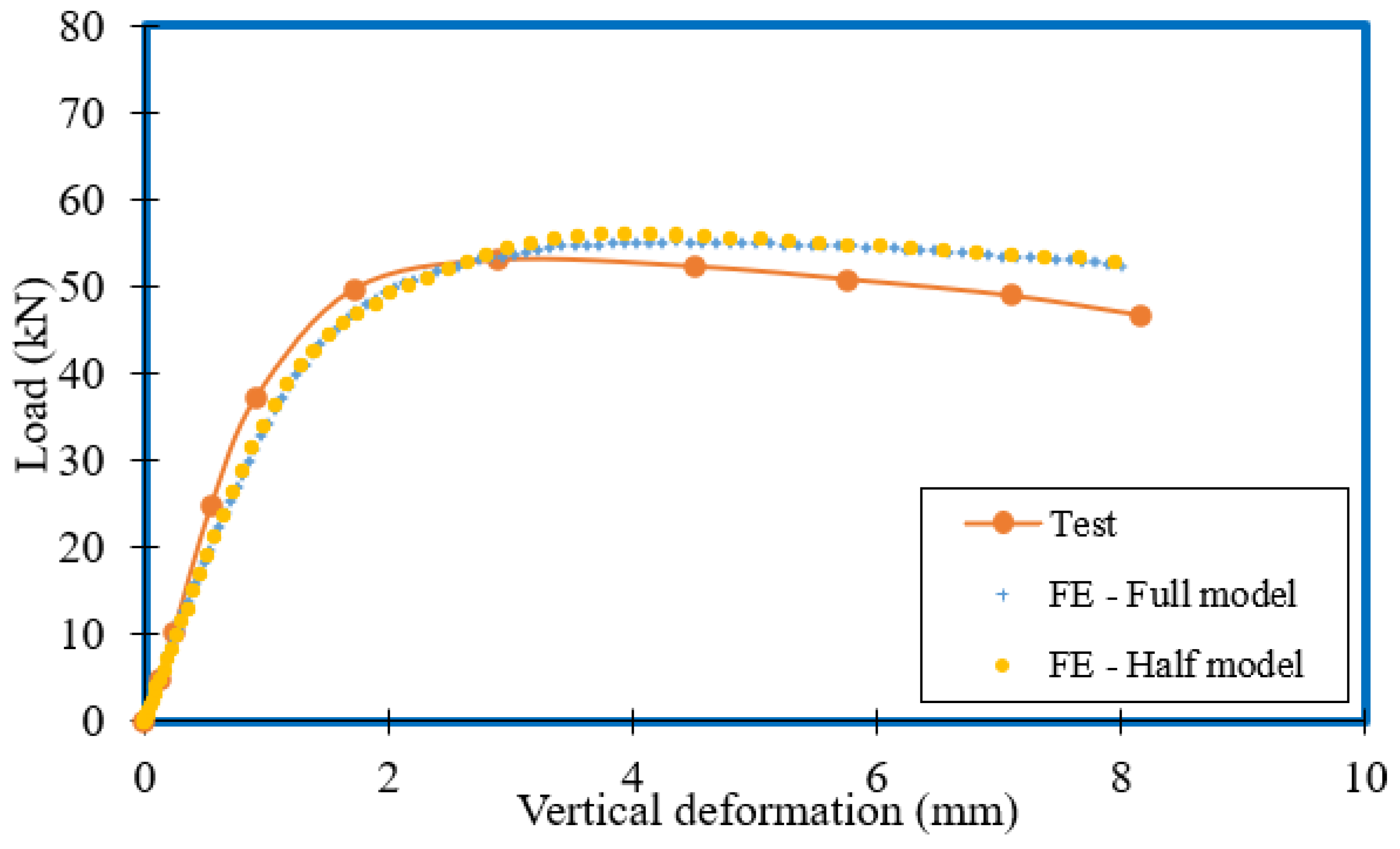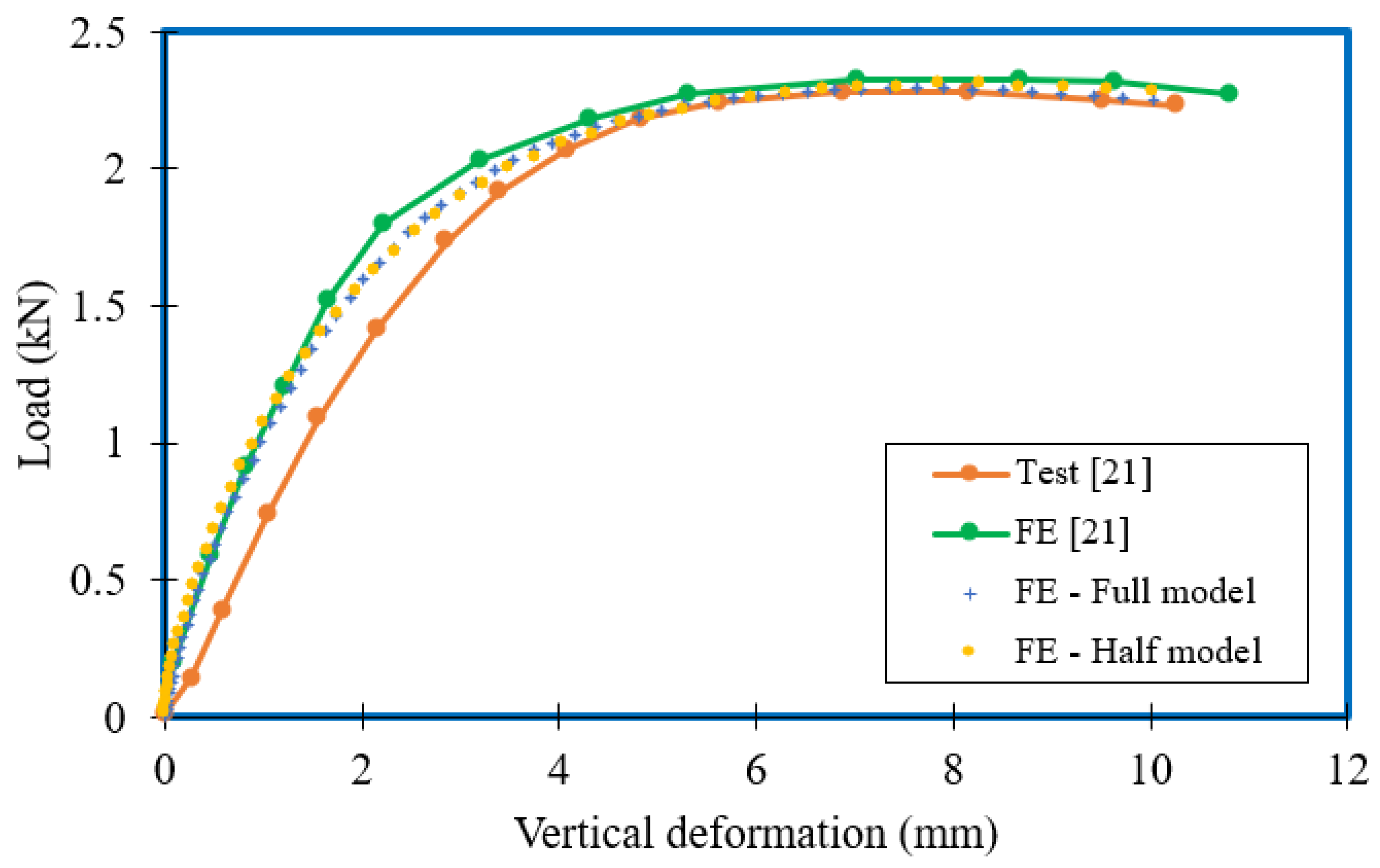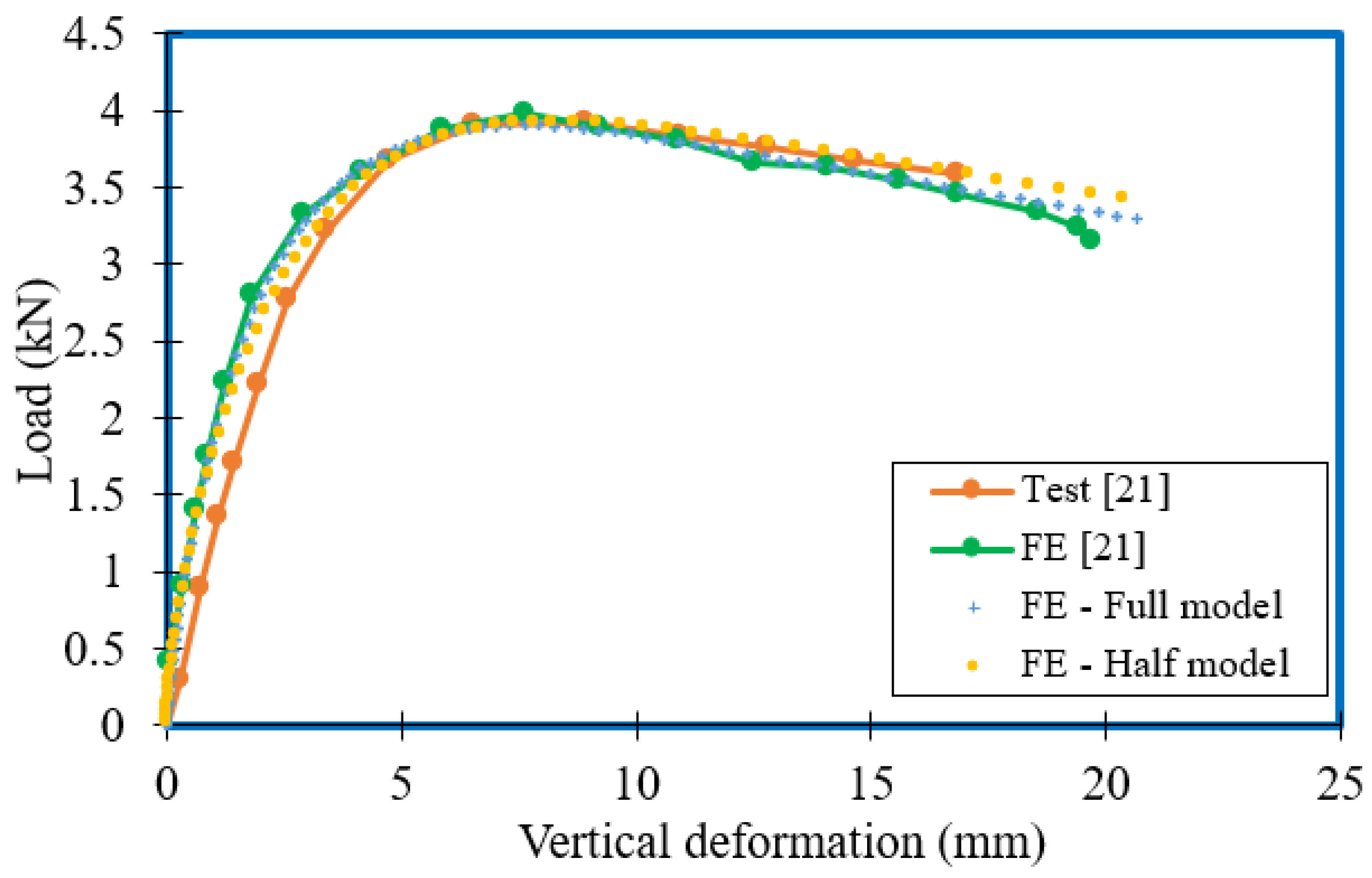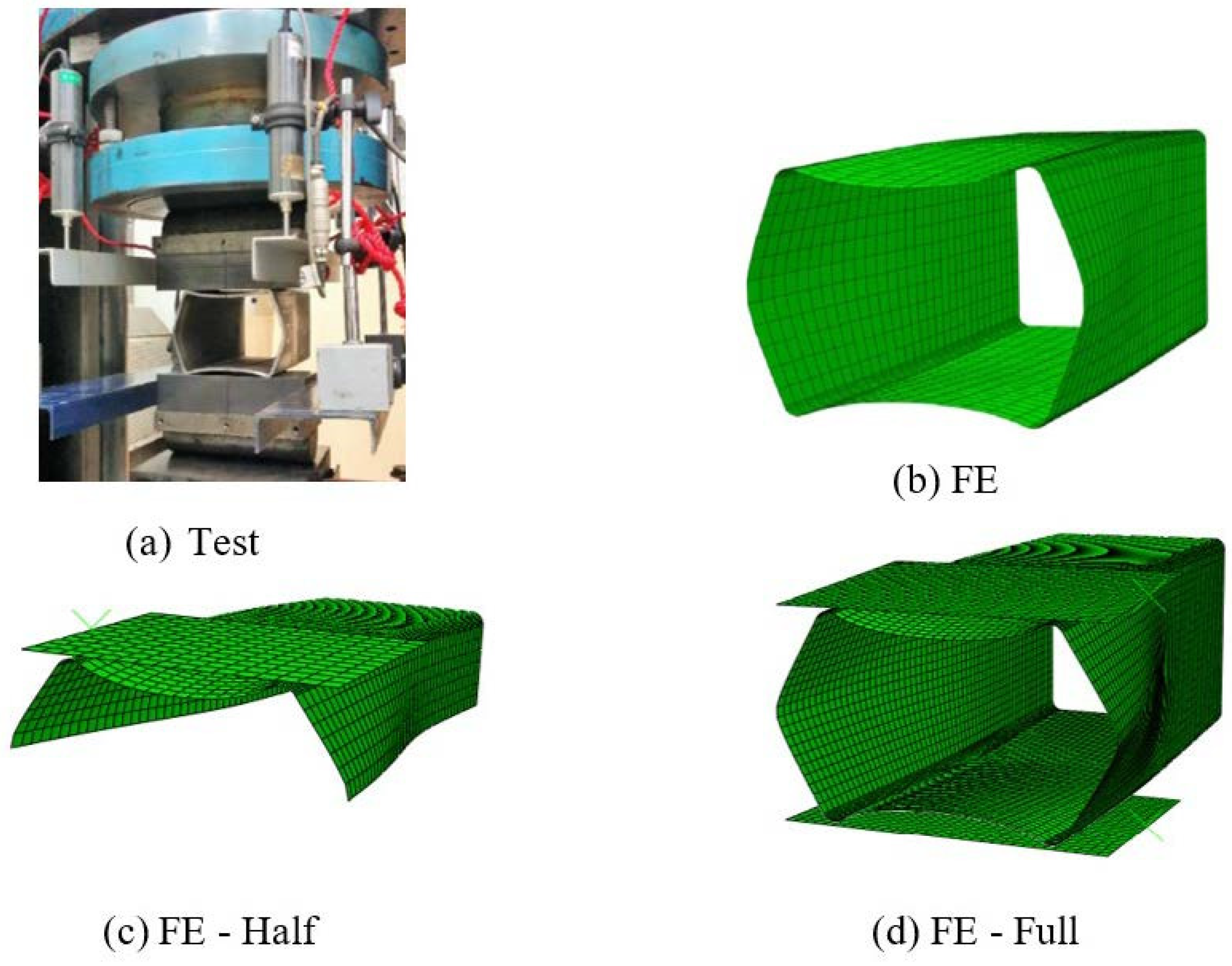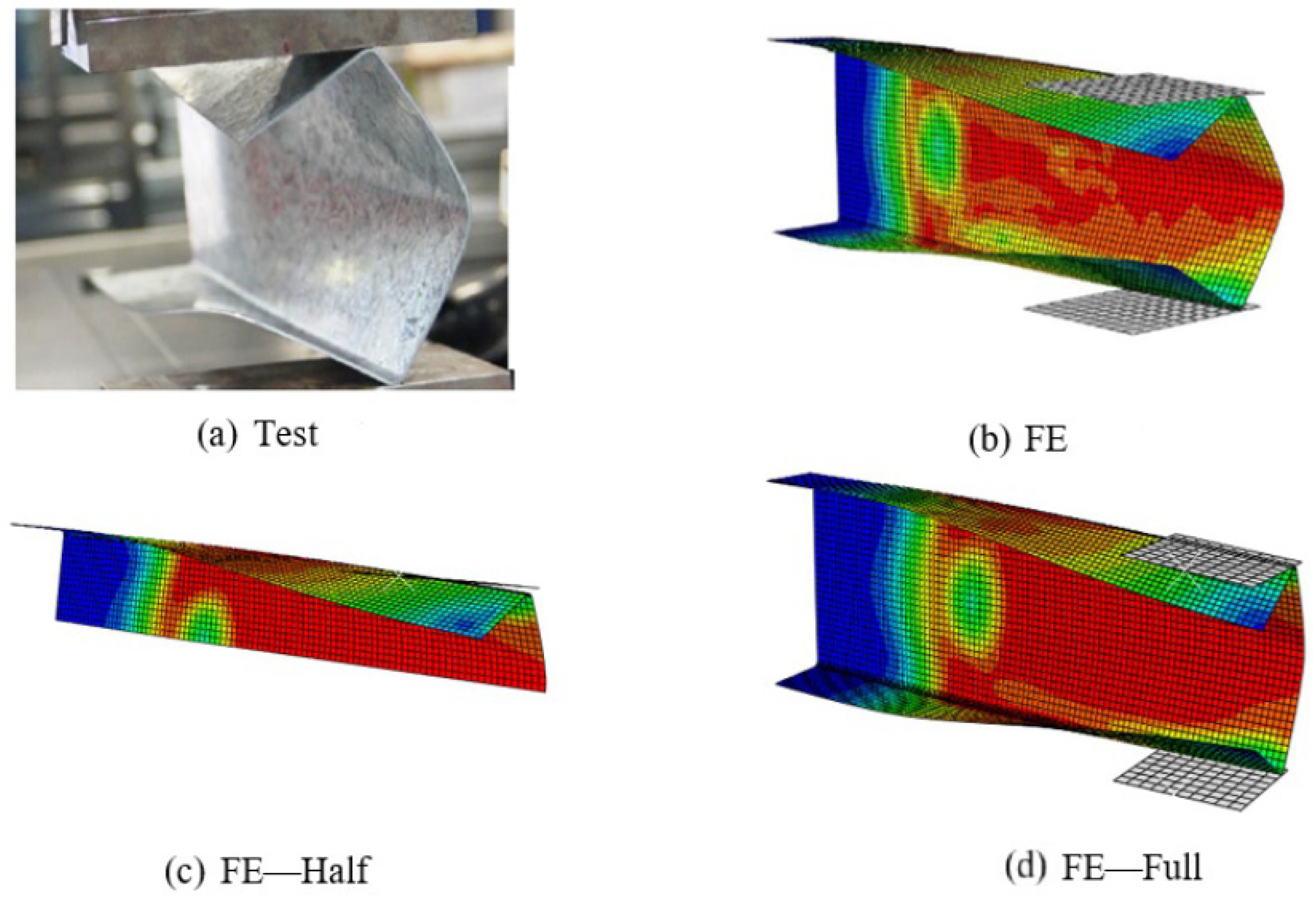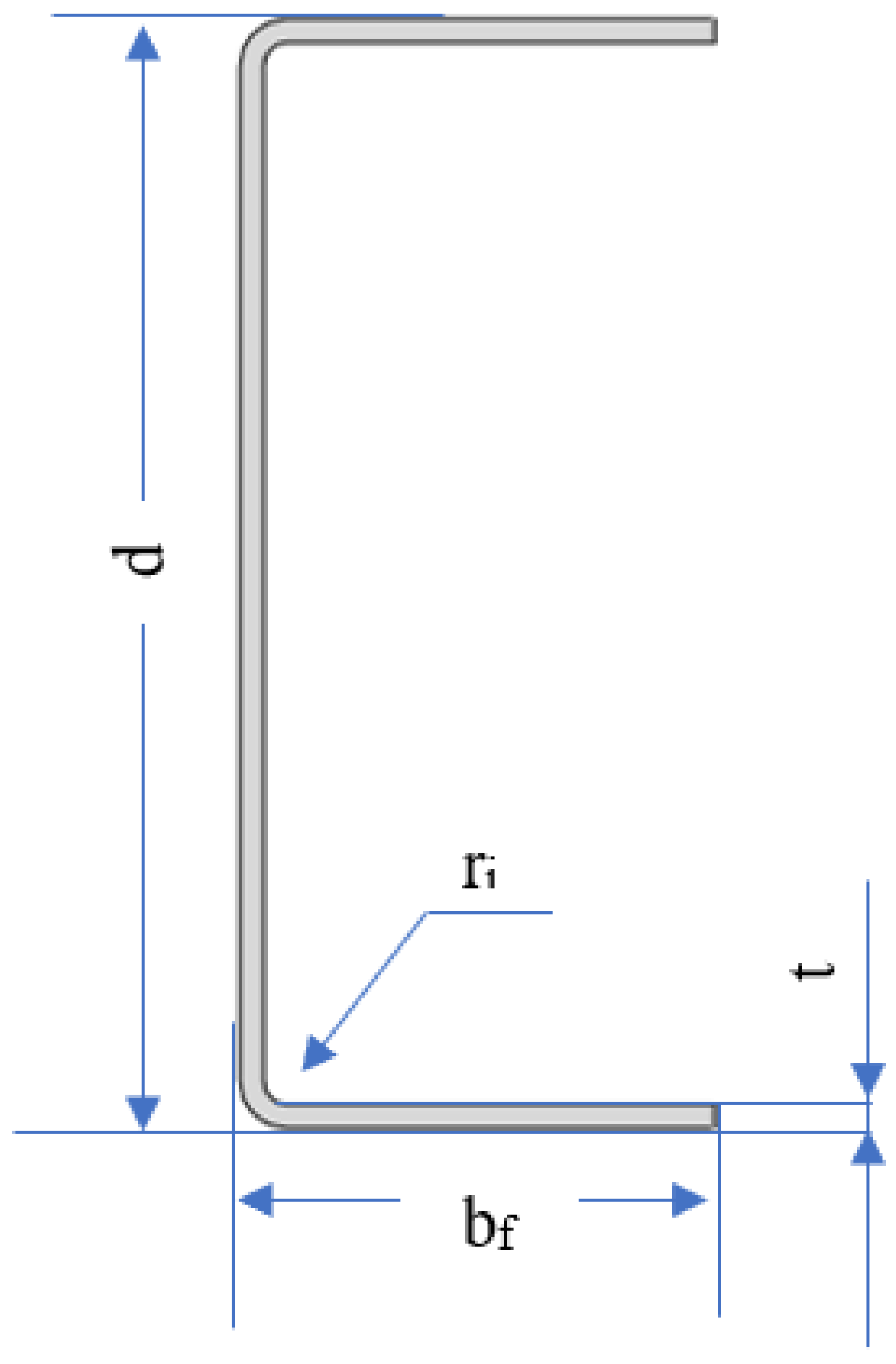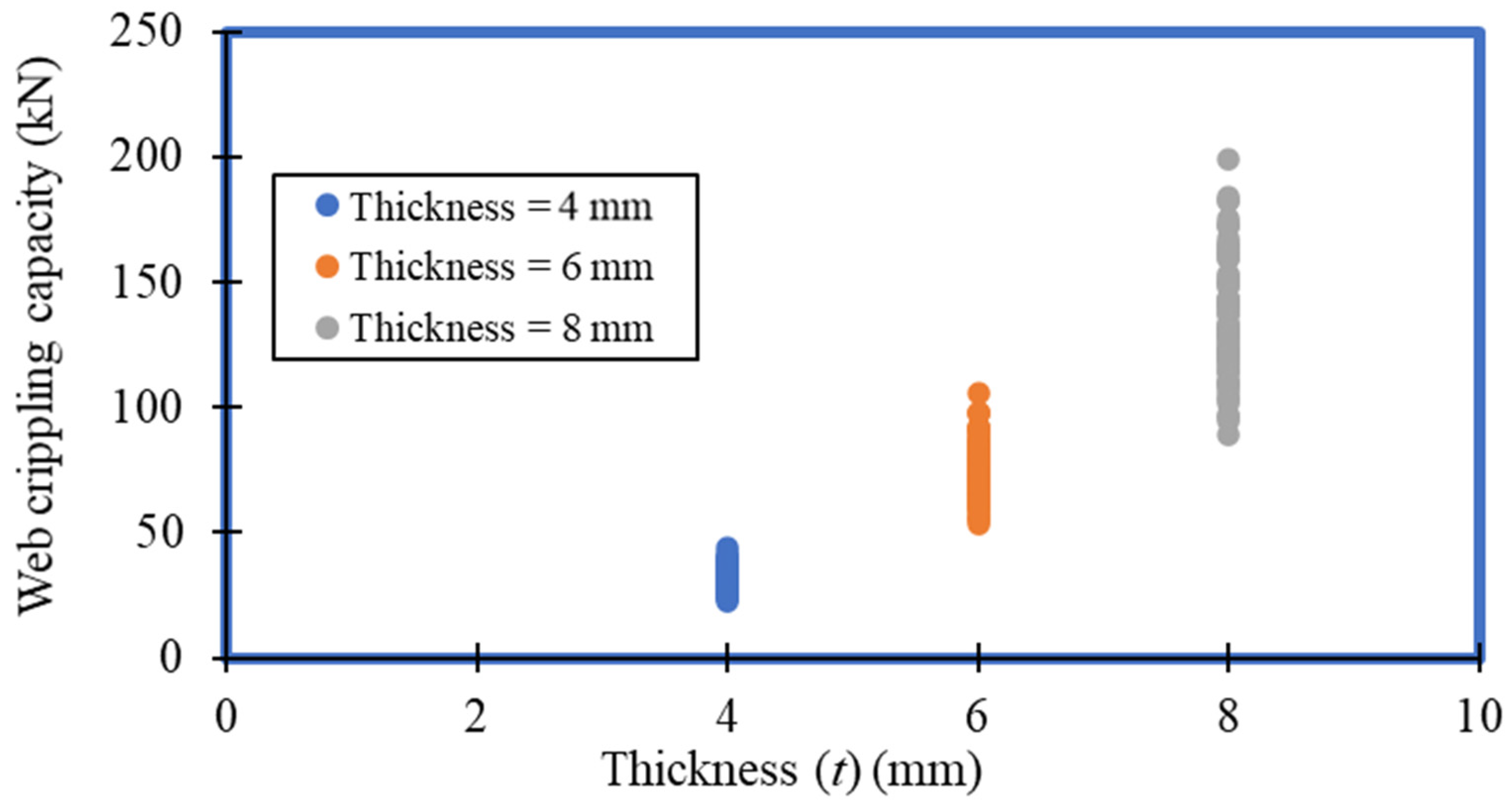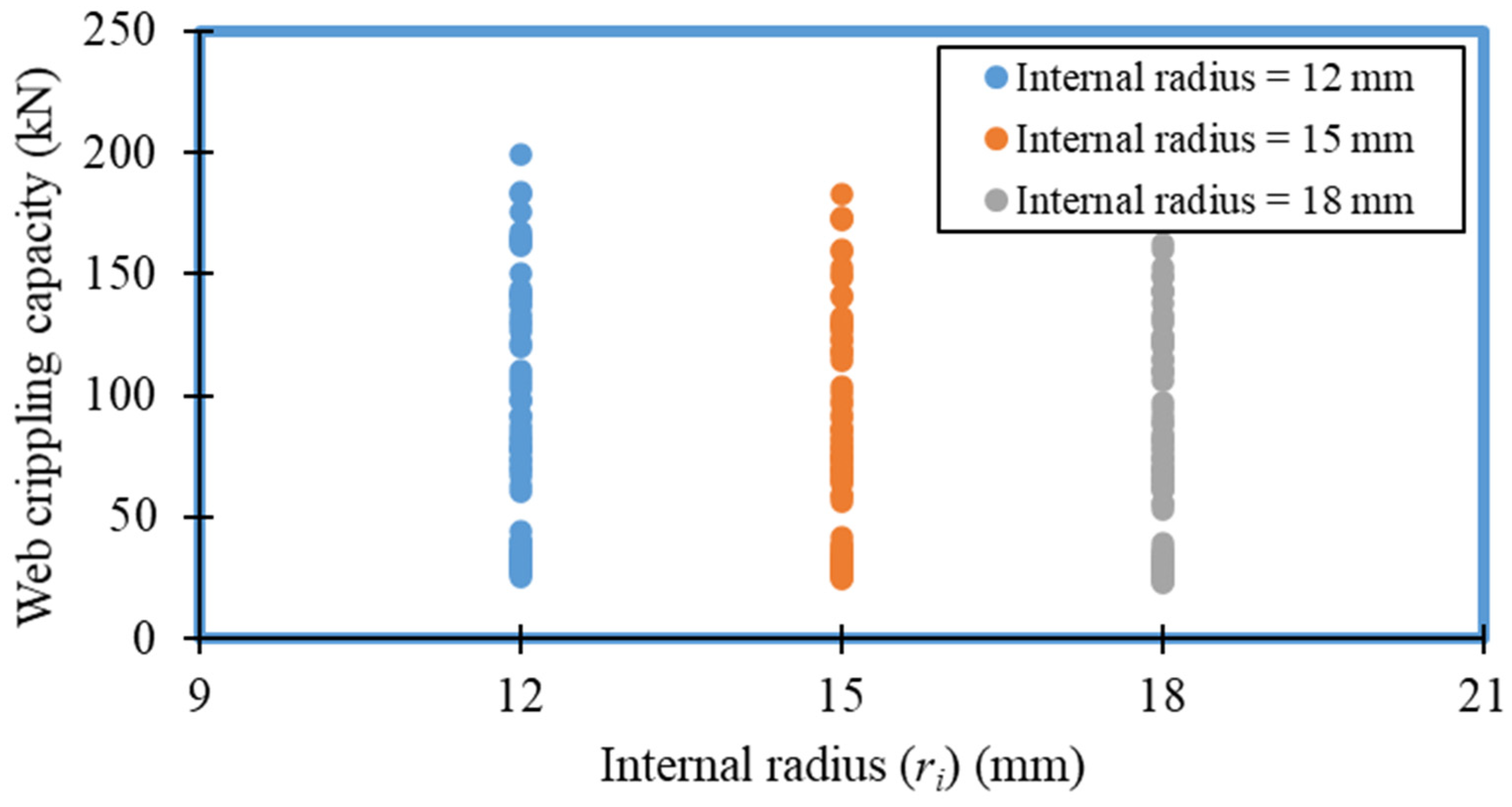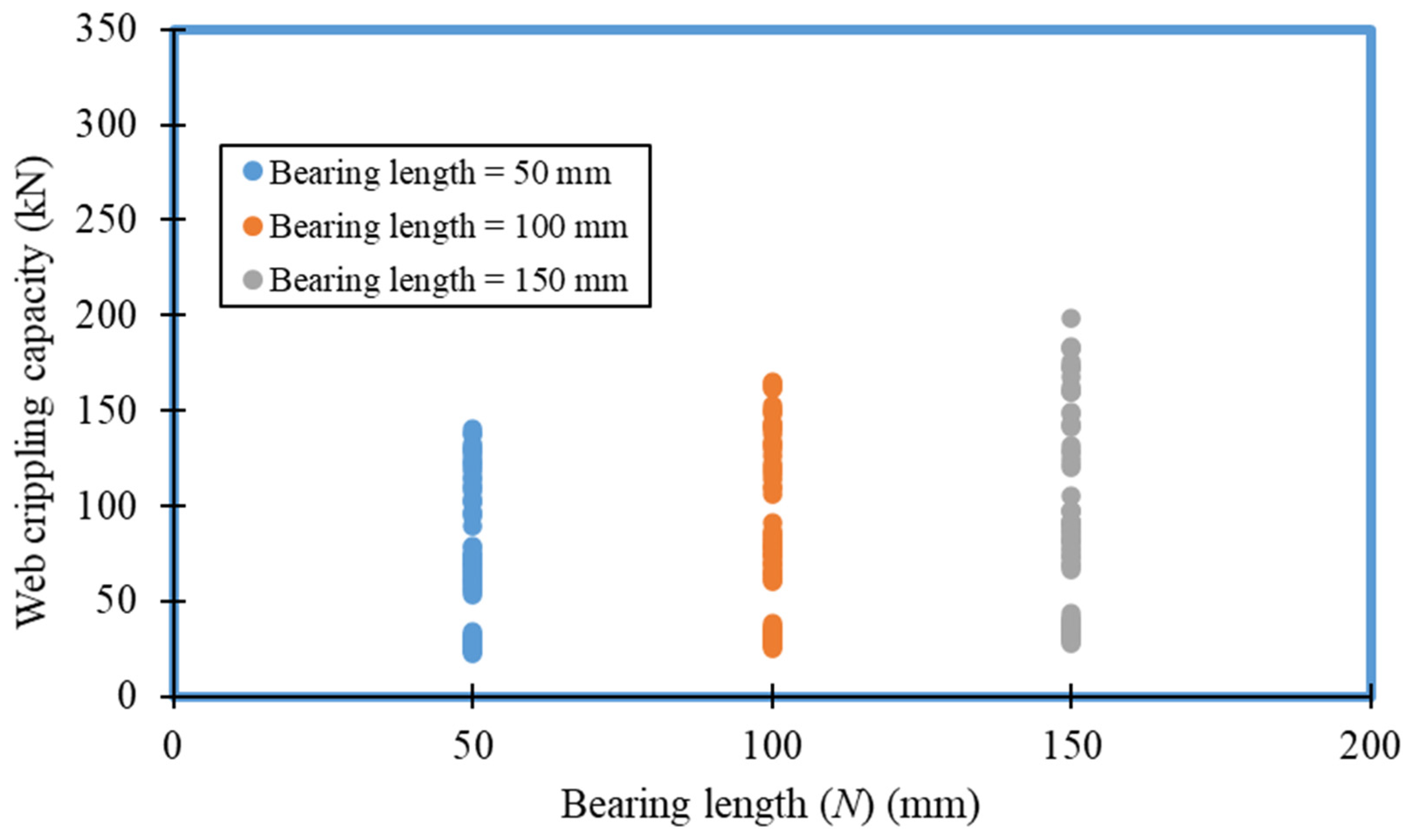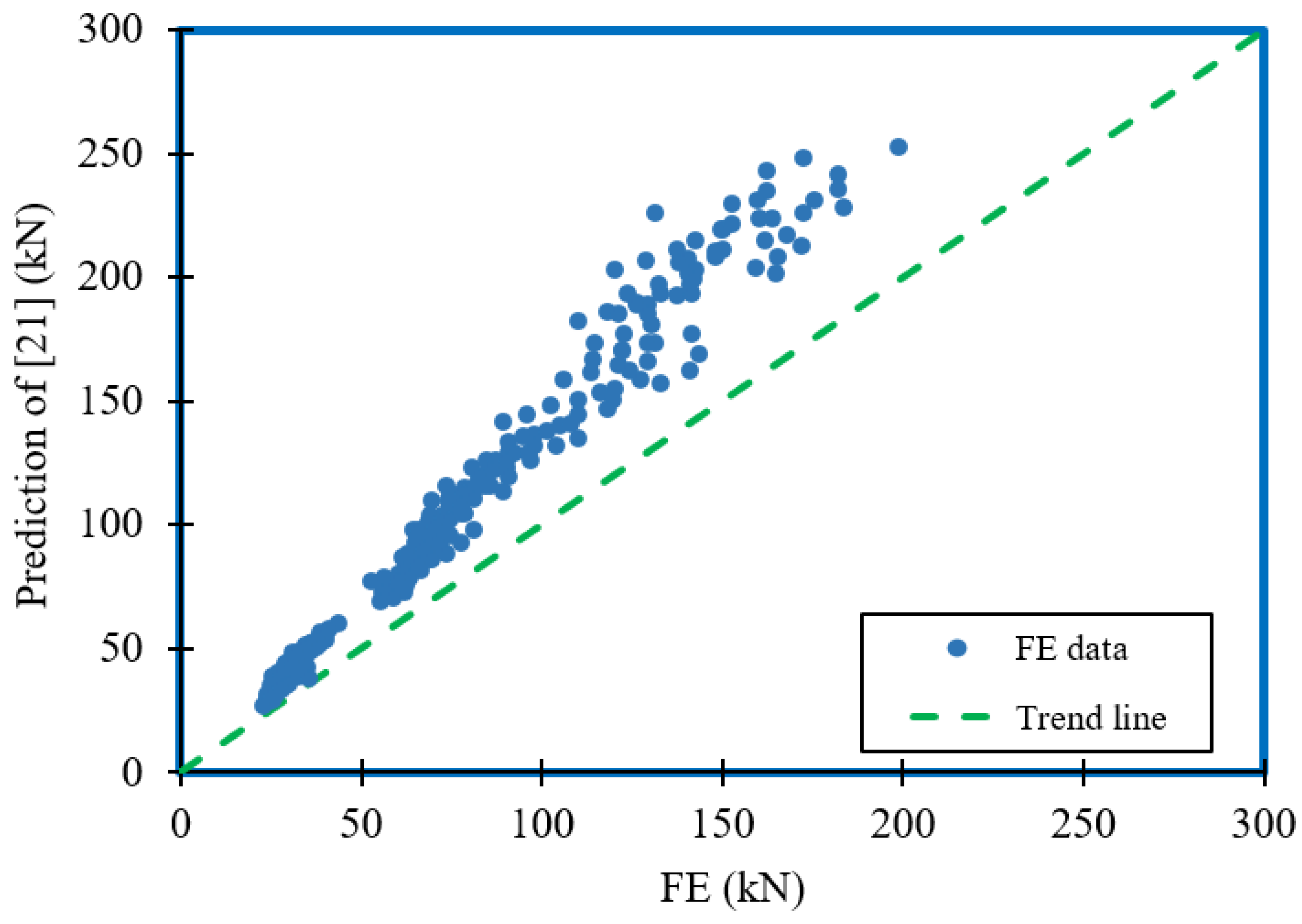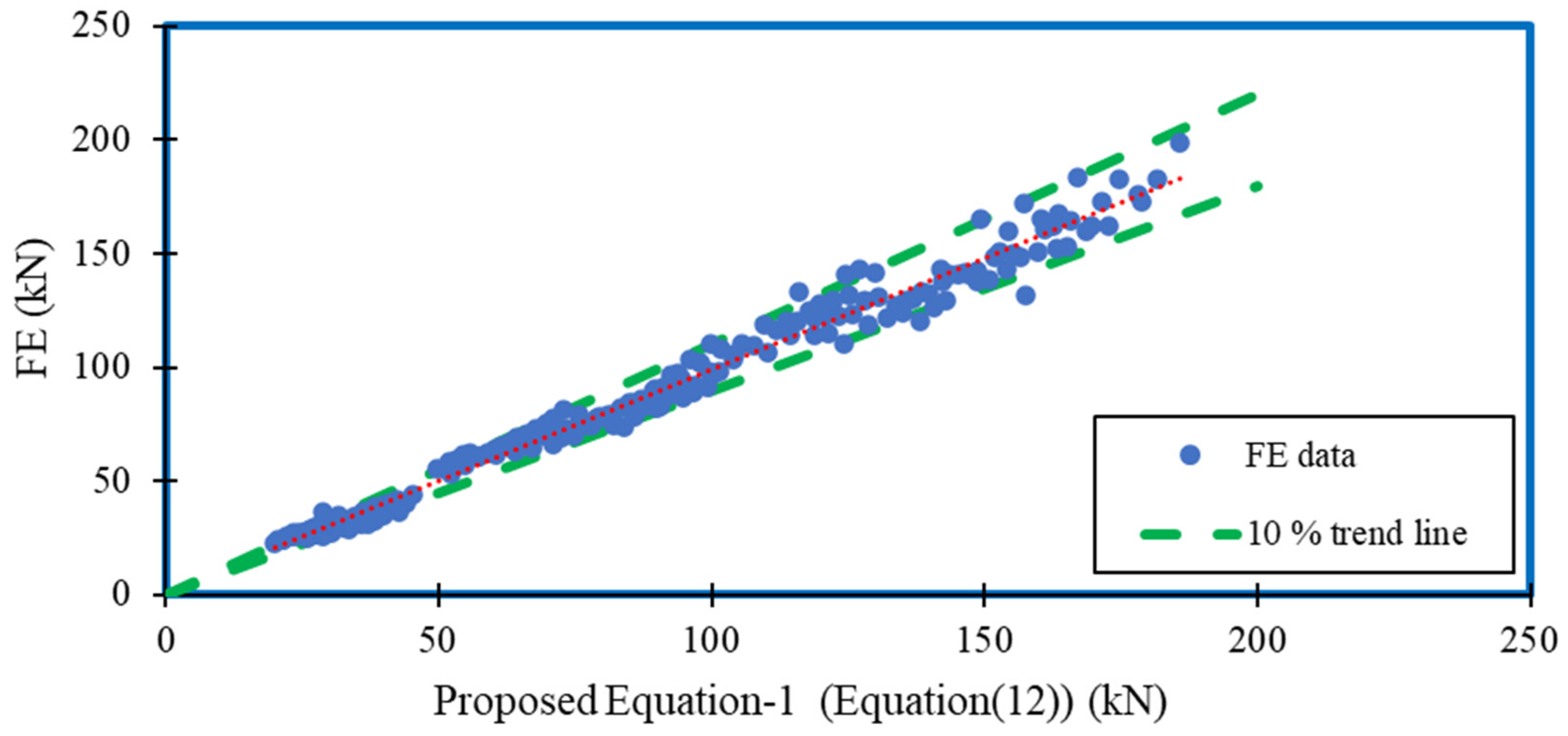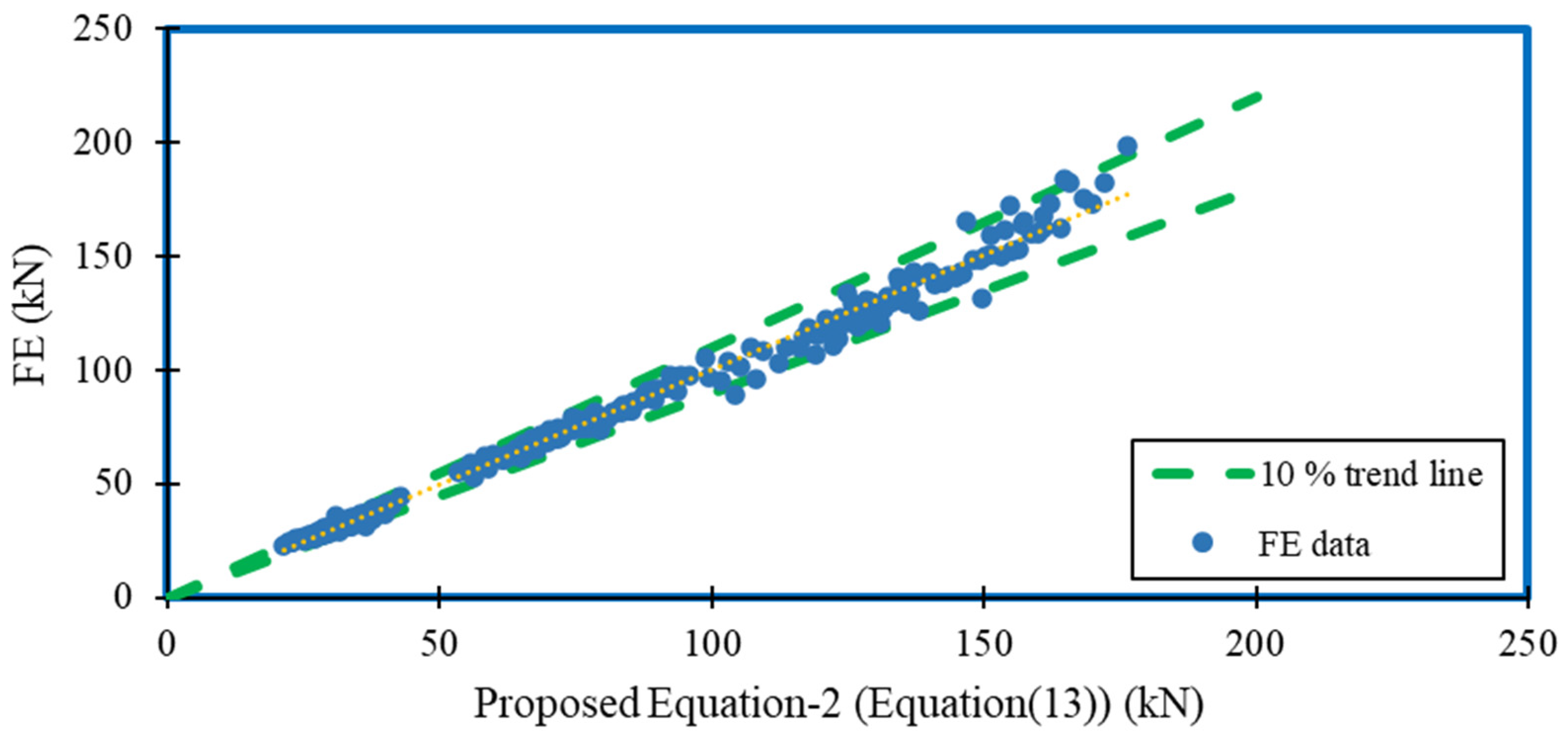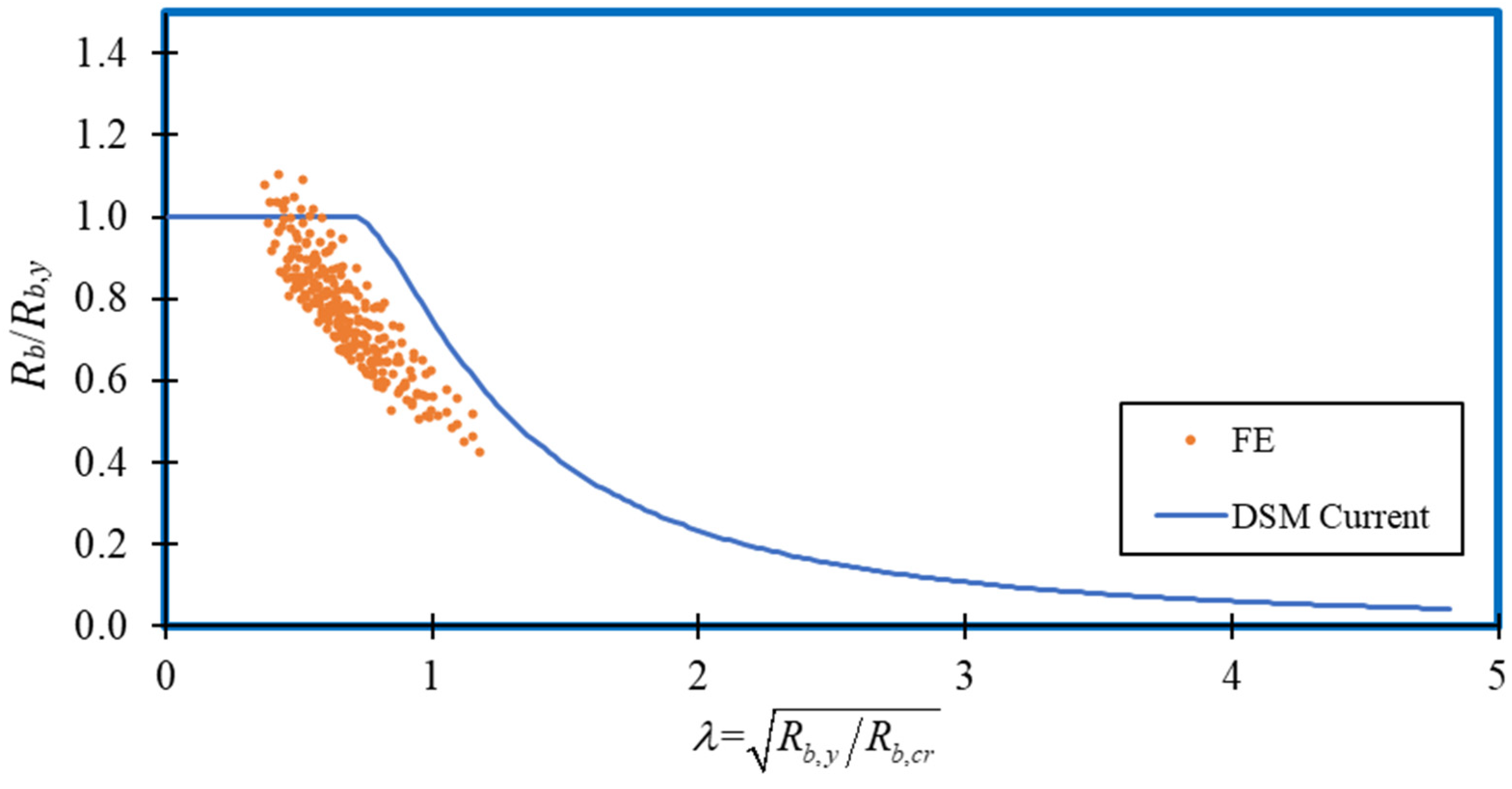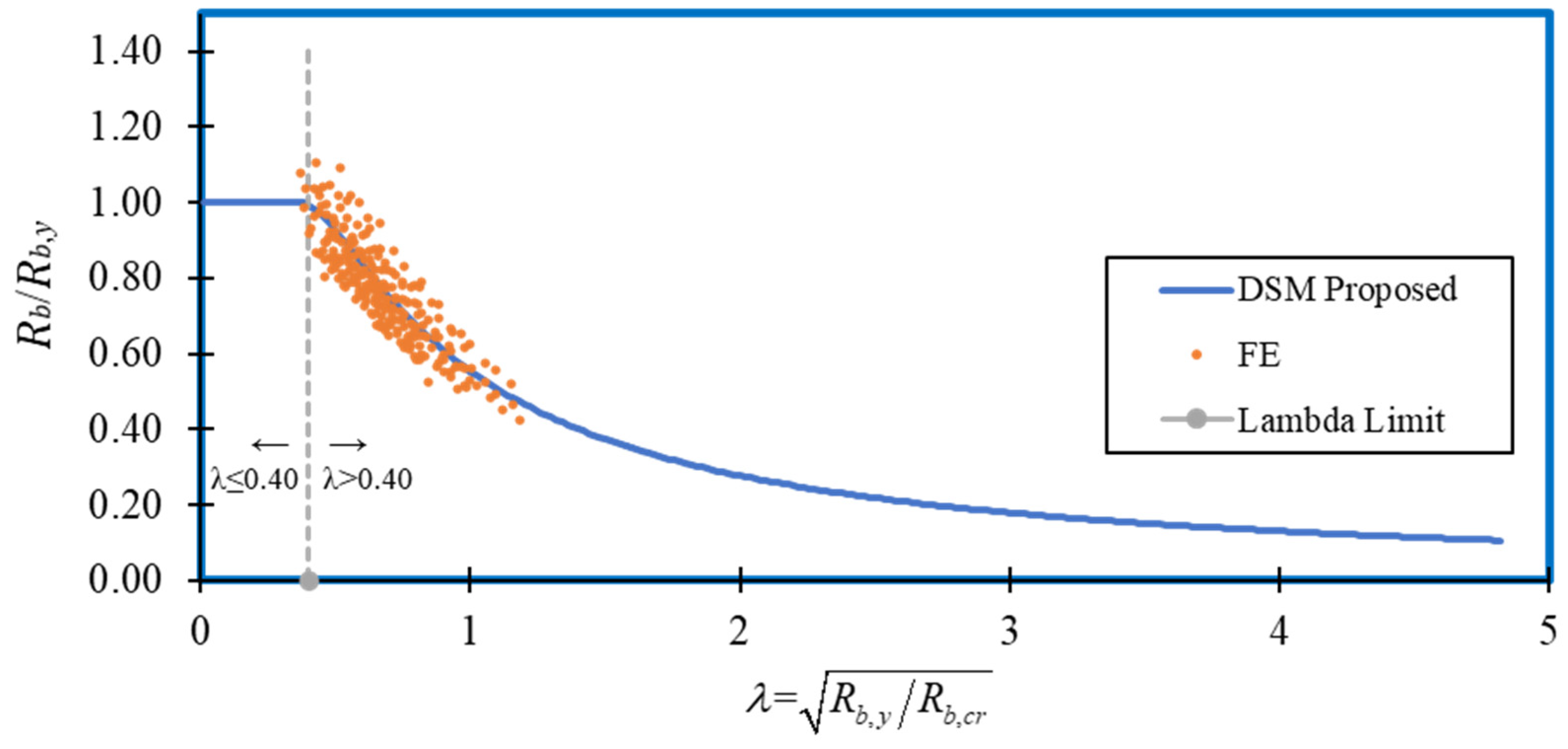1. Introduction
Cold-formed steel members have been extensively used in structural frame systems due to their prominent advantages, including light weight, durability, stability, high accuracy in fabrication, efficient erection, high strength-to-weight ratio and high stiffness. Different shapes of CFS sections, such as LiteSteel Beam (LSB) and built-up sections, as well as conventional sections (Z-section, C-section, ∑-section and track sections), have been developed to meet construction needs [
1]. High strength steel is one of the great additions to the construction industry; it is capable of fulfilling structural design needs such as longer spans, higher strength with reduced construction mass, higher load-carrying capacity and reduced self-weight in high-rise buildings [
2]. The structural performance of high strength steel sections has been studied by various researchers [
2,
3,
4,
5]. Web crippling is a vulnerability of CFS members under concentrated reactions and concentrated transverse reactions due to their thin cross sections. Since the 1940s, several experimental investigations of the web crippling behaviour of cold-formed steel sections [
6,
7,
8,
9,
10,
11] have been conducted by researchers, and web crippling design equations and standards have been adopted in design specifications such as Eurocode 3 Part 1–3 [
12], AISI S100 [
13] and AS/NZS 4600 [
14]. In addition, the design specifications assign the failure modes of web crippling to four categories—Interior-Two-Flange (ITF), End-Two-Flange (ETF), End-One-Flange (EOF) and Interior-One-Flange (IOF)—according to the locations of the loading, supporting and failure region [
13]. The web crippling load cases are illustrated in
Figure 1.
The web crippling behaviour of CFS channel sections under all four load cases, considering different supporting conditions (fastened support to the flanges or unfastened support to the flanges), has been investigated, and improvements in the codified design equations have been proposed [
15,
16,
17,
18,
19,
20,
21,
22,
23,
24,
25,
26,
27,
28,
29,
30,
31,
32,
33,
34,
35]. Moreover, web crippling studies have been conducted on various sections, such as rectangular hollow flange sections [
36,
37,
38,
39] and SupaCee sections [
17,
40], to check the applicability of the codified design equations available in the standards, whilst some studies have investigated the web crippling behaviour of various sections with web openings [
41,
42,
43,
44,
45]. However, all these findings are limited to a yield strength less than 500 MPa, due to the unavailability of cold-forming technology [
5]. High strength steel sections are receiving attention from the construction community due to their added benefits in terms of structural and architectural behaviour [
5]. The researchers Santaputra et al. [
3] and Wu et al. [
4] studied the web crippling of high strength steel, including brake-pressed hat and built-up sections and hat and deck sections, respectively. The study of Santaputra et al. [
3] covered a steel section strength of 401 to 1138 MPa, whilst Wu et al. [
4] considered the virgin material yield stresses parallel to the rolling directions, ranging from 716 to 776 MPa, and perpendicular to the rolling directions, ranging from 825 to 894 MPa. Furthermore, web crippling investigation on high strength tubular sections (square and rectangular) under all four load cases was carried out by Li and Young [
2,
5]. The researchers considered the yield strengths of 700 MPa and 900 MPa in their study [
2,
5]. Sundarajah et al. [
18] investigated the web crippling behaviour of high strength steel lipped channel sections under EOF and IOF loading conditions. The study also limited the investigation to less than 550 MPa.
This paper investigates the web crippling behaviour of unlipped channel sections under the ETF load case, with high strength material (yield strength of 700 MPa, 900 MPa and 1000 MPa). In total, 243 numerical studies, following the validation study, were conducted to investigate the web crippling behaviour and evaluate the applicability of current design equations available in standards. The test specimen length and loading conditions were chosen as denoted in the design specifications [
12,
13,
14]. Web crippling strengths for this study were compared to the predictions of codified design equations provided in the design standards [
12,
13,
14] and with previous studies on cold-formed unlipped channel sections [
21,
22]. Finally, this paper proposes a modified design equation for the web crippling capacity of CFS lipped channel sections with high strength under the ETF load case based on the current design standards. A DSM design equation was also proposed for this study.
2. Finite Element Modelling Description
The web crippling behaviour of channel sections can be predicted using Finite Element (FE) software and using experimental studies available in the literature [
17,
19,
20,
21,
22,
23,
24,
25,
26,
27,
36,
40]. The experimental set-up of channel sections as shown in
Figure 2 is simulated using ABAQUS version 6.14 (developed by Dassault Systèmes Simulia Corp., Johnston, RI, USA) [
46] to extend the study of the web crippling of unlipped channel sections with high strength material. In this study, full and then half models with axial symmetry assignment along the symmetrical line were analysed during the validation (
Figure 3). Similar behaviours in both models were obtained and are discussed in
Section 3 in detail. The number of elements and Degree of Freedoms (DoFs) for the half models are less than that of the full model, and thus reduced analysis time was observed for the half model as compared to the full model. In addition, a simplified modelling process was addressed during the half model development. Hence, the half model set-up was adopted during the parametric studies and is described herein.
2.1. Element Type and Mesh
The FE model was developed with two major parts: the cold-formed channel beams and bearing plate. The 3D deformable shell element type of S4R was assigned to the cold-formed steel beam, whilst rigid element R3D4 was used to create the bearing plates. Although various types of elements are available in the ABAQUS, the above-mentioned element types were chosen according to the various previous numerical studies conducted on web crippling [
2,
16,
17,
19,
25,
26,
27]. Since the shell offset definition was set to be the middle surface, the centre-line dimensions were simulated in accordance with the ABAQUS. This means the middle surface would act as a reference surface, and an assigned thickness will be added to both sides of the reference surface with half of the thickness [
46]. Mesh size is rather crucial factor in deciding the accuracy of numerical results. Mesh size of the cold-formed steel beam was adopted in this study as indicated in the previous web crippling studies based on mesh refinement analysis [
16,
17,
18,
19]. In this study, the mesh size of the flat region and corner regions was 5 mm × 5 mm and 5 mm × 1 mm, respectively. The applied mesh sizes and element types are shown in
Figure 4. Plastic deformation at the web-flange juncture and appropriate load transfer to the web from the flange is significantly influenced by the corner region, and thus finer mesh is recommended for the corner radii in the web crippling studies [
16,
17,
18,
19]. Since the rigid plate does not take part in the finite element analyses, the mesh size of the bearing plate was assigned as 10 mm × 10 mm.
2.2. Material Modelling
The two-stage Ramberg–Osgood model is used to describe the stress–strain behaviour of the stainless steels and cold-formed steels. Even though a number of researchers have investigated the behaviour of stainless steel [
47,
48,
49,
50,
51], only a few researchers have studied the material modelling of cold-formed steel [
52,
53]. Recently, Leroy Gardner and Xiang Yun [
54] proposed a two-stage Ramberg–Osgood model (Equations (1)–(6)) to describe the stress–strain curve of the cold-formed steel, which is based upon the material model developed by Mirambell and Real [
51] for stainless steel. The researchers [
54] gathered many stress–strain models from a literature review by considering various material strengths, shapes and forms of production, such as press-braked or cold-rolled and validated. In addition, the study [
54] suggested that the study of Rossi et al. [
55] can be used to obtain the material model of the corner regions (Equations (7)–(10)). The material models proposed by Gardner and Yun [
54] and Rossi et al. [
55] were applied in this study to determine the stress–strain behaviour of the flat and corner regions, respectively.
The applied stress–strain relationship of the flat region in this study is as follows:
The suggested values and expressions for the key input parameters in Equation (1) are as follows:
n—First strain-hardening exponent:
In this study, the first strain-hardening exponent was taken from following table (
Table 1) [
55].
E0.2—Tangent modulus of the stress–strain curve at the yield strength (0.2% proof stress):
εu —Strain corresponding to the ultimate tensile strength
fu:
For an unknown ultimate strength,
fu:
m—Second strain-hardening exponent:
fy,c—Enhanced yield strength of corner regions of cold-rolled or press-braked sections:
εc,av—Average plastic strain induced during the forming of the corner regions of press-braked and cold-rolled sections:
p and
q—Material parameters calculated directly from the basic properties of the unformed material:
Figure 5 shows the applied material stress–strain curve of the flat and corner regions for a yield strength of 700 MPa. The derived engineering stress–strain curve is then converted to a true stress–strain curve, as stated in the ABAQUS [
46]. Then, a weight density of 7850 kg/m
3, Young’s modulus of 203,000 MPa and Poisson’s ratio of 0.3 were applied as the material properties.
2.3. Loading and Boundary Conditions
Since full and half models were developed during the validation, different boundary conditions were applied to the two models, as shown in
Figure 6. The boundary conditions respective of loading and supporting were applied to the bearing plate via a reference point on the plates, whilst boundary conditions were employed for the symmetry line of the channel section to replicate the symmetrical type used for the cold-formed steel beam in the half models. Translation of the loading plate along the X-axis and Z-axis and rotation about the Y-axis and Z-axis were restrained, whilst a −20 mm displacement was applied in the vertical direction to simulate the experimental set-up of web crippling studies. The supporting plate in the full model was restrained with all movements, except rotation about the X-axis. As half hinges are used in the experimental set-up, loading and supporting plates are allowed to rotate about the X-axis. Vertical displacement at the loading plate was controlled using an amplitude model of smooth step, which ensures the smooth deformation from the initial stage. Various types of boundary conditions are available in the ABAQUS, and the symmetrical (symmetry/antisymmetry/encastre) type of boundary condition was applied along the symmetrical line of the cold-formed beam. The translation along the Y-axis and rotation about the X-axis and Z-axis were restrained along the symmetrical line. Previous studies also used similar boundary conditions for web crippling studies [
2,
16,
17,
19,
25,
26,
27,
31,
36,
37,
38].
2.4. Contact Formulation and Properties
Interactions between bearing plates and the cold-formed steel beam were assigned by generating the surface-to-surface contacts with contact properties. Even though contact formulation can be described using various methods, such as general contact, contact pair and surface-to-surface contact, the surface-to-surface contact method was employed in this study in accordance with previous research [
2,
17,
19,
26,
27]. Rigid bearing plates were defined as master surfaces, whereas the flange of the beam and corner radii were specified as slave surfaces during the contact formulation. Normal and tangential behaviours were also assigned in the contact formulation. For the contact properties, a pressure overclosure of “hard” contact in the normal direction and a friction formulation of a penalty with a 0.4 friction coefficient were employed [
21,
25,
36].
2.5. Analysis Method
ABAQUS/Implicit and ABAQUS/Explicit are capable of solving the static and quasi-static problems in the ABAQUS [
46]. However, due to the convergence issues that occurred during the application of the ABAQUS/Implicit analysis method, ABAQUS/Explicit was employed in this study to simulate the web crippling behaviour of the channel section. Previous studies also investigated the application of various analysis methods and revealed that the explicit method requires a huge number of increments; thus, the method can be more efficient and is more suitable for complex nonlinear problems as well as convergence issues generated by the other solver options [
19].
2.6. Initial Geometric Imperfections
The effect of initial geometric imperfection has been neglected in various research studies, since it does not greatly affect the ultimate web crippling capacity [
19,
26]. Therefore, the effect of geometrical imperfection was not considered in this study.
2.7. Residual Stresses
Residual stresses can be categorized into flexural/bending and membrane residual stresses. However, previous studies have stated that the effects of membrane and flexural residual stresses on the web crippling capacity are less than 0.5% [
25]; therefore, the residual stress effect was not considered in this study.
3. Validation of Numerical Models
Web crippling experimental studies on tubular sections with high strength cold-formed steel [
2,
5] and unlipped channel sections with yield strengths of 500 MPa to 600 MPa [
21] under ETF loading conditions were validated in this study to ensure the accuracy of the numerical model. The developed FE models were verified by comparing the (i) web crippling failure loads, (ii) failure modes and (iii) applied load vs. vertical deflection curves with corresponding experimental results [
2,
5,
21]. Since half models were used in this study during the parametric studies, both the full and half models generated and validated are presented here. A good agreement was obtained for the models, and less analysis time was required for the half models compared to the full models. Thus, the authors used the half models during the parametric studies.
A comparison based on the web crippling failure load (ultimate load) of the ten experimental studies was carried out for both the full and half models and is presented in
Table 2 and
Table 3 for tubular sections and unlipped channel sections, respectively. The validation was conducted for a material strength of 700 MPa and 900 MPa for tubular sections, whilst for unlipped channel sections, a strength of 500 MPa to 600 MPa was used. The mean and COV values for the ratio between the experimental and FE results were also observed, as shown in
Table 2 and
Table 3. The mean value and COV of tubular sections with high strength material for the full model were 0.94 and 0.05, and for the half model they were 0.95 and 0.05, respectively. Meanwhile the mean and COV of unlipped channel sections for full models were 1.00 and 0.02, and for half models they were 1.00 and 0.03. A summary of the validation results is given in
Table 4. The comparison indicated that developed FE models were capable of predicting well the experimental study, with less than 10% deviation under the ETF loading condition in terms of failure load.
The numerical models were validated based on the load vs. vertical deformation curve for both tubular and unlipped channel sections [
2,
21]. The load vs. vertical deformation curve for tubular section ETF H120X120X4 with a bearing plate length of 60 mm was plotted against the load–vertical deformation curve of numerical models, whilst three experimental studies of unlipped channel sections, including ETF-UC10012 with 50 mm bearing length, ETF-UC15015 with 100 mm bearing length and ETF-UC20015 with 150 mm bearing length, were compared for unlipped channel sections. The curves were also compared for both the full and half models to ensure the usage of half models in the parametric study. The obtained plots are shown in
Figure 7,
Figure 8,
Figure 9 and
Figure 10; FE models represented the experimental load–vertical deformation curve well.
Finally, the validation was performed by comparing the failure modes. The failure mode of the tubular section (ETF H120X120X4 with a bearing plate length of 120 mm) and unlipped channel sections (ETF-UC10012 with 50 mm bearing plate, ETF-UC15015 with 100 mm bearing plate, ETF-UC20015 with 150 mm bearing plate) for both the full and half models was compared. A good agreement was observed and is illustrated in
Figure 11,
Figure 12,
Figure 13 and
Figure 14. The comparison shows that the failure modes of FE models match well with their experimental counterparts.
The comparison of FE models with experimental studies showed that the numerical model for both the full and half models is capable of predicting the web crippling capacity of cold-formed beams with high strength material under the ETF loading condition. However, reduced analysis time was observed for the half model in comparison to that of the full model, and thus half models were used to perform the parametric study of the cold-formed channel section with high strength undergoing web crippling under the ETF loading condition. Since accurate results were obtained in the validation, the parametric study was extended using numerical analyses.
4. Parametric Study
The validated FE models were incorporated in a comprehensive parametric study to generate a database of high strength steel unlipped channel sections subject to ETF loading to investigate their web crippling behaviour. The geometric and material parameters of section depth (
d), width (
bf), thickness (
t), corner radius (
ri), bearing length (
N) and steel grade (
fy) were varied during the study, covering a range of section slenderness values.
Figure 15 shows the notations used for key cross-sectional dimensions of unlipped channel sections. The available web crippling design rules were then assessed, and improved design provisions were proposed to increase the accuracy of web crippling resistance predictions in succeeding sections using the generated database of unlipped channel sections.
Table 5 summarises the key parameters that were considered during the parametric study. Since high strength steel sections have been applied in various areas [
56,
57], the material strength was chosen by considering those applications and by focusing on the potential applications of high strength channel sections in the construction industry in the near future. Meanwhile, the geometric parameters of the parametric study were selected in accordance with commercially available channel sections. The section heights of unlipped channel sections varied between 150 mm and 250 mm, whilst the section thicknesses varied between 4 mm and 8 mm. The developed FE models had corner radii ranging from 12 mm to 18 mm, whilst bearing lengths varied from 50 mm to 150 mm. Three different yield stress values, from 700 MPa to 1000 MPa, were considered in the study. In total, 243 FE models of unlipped channel sections were generated during the parametric study.
The FE results, including web crippling resistances and failure modes of unlipped channel sections under the ETF loading case, are analysed in the coming sections to assess the web crippling behaviour and design provisions, with the aim of providing efficient design rules to increase the range of application of unlipped channel sections in structures.
5. Parametric Study Results
The ultimate web crippling capacity of lipped channel beams was obtained for 243 numerical studies.
Figure 16 shows the typical web crippling failure modes of unlipped channel beams using corresponding pictures of the points indicated in the load vs. vertical deformation curve. The failure modes of the 200 mm section (
t = 6 mm,
N = 150 mm,
ri = 12 mm and
fy = 1000 MPa) are illustrated for the (i) initial, (ii) before-peak, (iii) at-peak and (iv) post-peak stages in
Figure 16. The web crippling capacities of the 243 parametric studies are given in
Table 6.
The effect of various parameters, such as section thickness (t), internal radius (ri) and bearing length (N) of the channel section, are investigated in the following subsections.
5.1. Effect of Thickness (t) on the Web Crippling Capacity
The web crippling behaviour of cold-formed steel sections varying in thickness is illustrated in
Figure 17. It can be noticed that the web crippling strength increases with the thickness of the section. From the parametric results, the web crippling strengths of section 150 × 60 (
ri = 12 mm,
N = 50 mm and
fy = 900 MPa) are 31.99 kN, 73.20 kN and 126.7 kN when thicknesses are 4 mm, 6 mm and 8 mm, respectively. Therefore, almost a 129% and 296% increment in web crippling strength was observed for the 6 mm and 8 mm thick sections, respectively, compared to the 4 mm thick sections in the corresponding study.
5.2. Effect of Internal Radius (ri) on the Web Crippling Capacity
The effect of corner radius on the web crippling strength of cold-formed steel sections is shown in
Figure 18.
Figure 18 clearly depicts a reduction of the web crippling strength with corner radius. For example, the web crippling strength of section 150 × 60 (
t = 4 mm,
N = 50 mm and
fy = 900 MPa) is decreased from 31.99 kN to 28.37 kN when the corner radius is increased from 12 mm to 18 mm. To the above-mentioned parametric study, web crippling strength is reduced by 5.8% and 11.3% for the sections with 15 mm and 18 mm corner radii, respectively, compared to the section with the 12 mm corner radius.
5.3. Effect of Bearing Length (N) on the Web Crippling Capacity
The web crippling capacity of cold-formed steel sections also depends on the bearing length of the loading and supporting plates.
Figure 19 shows how the web crippling capacity of the unlipped channel section varies with the bearing length. An upward trend in web crippling capacity is noticed with an increase in the bearing length. The web crippling capacity of section 150 × 60 (
t = 4 mm,
ri = 12 m and
fy = 900 MPa) with 50 mm bearing length is 31.99 kN, which is increased to 36.31 kN and 40.23 kN when the bearing length is increased to 100 mm and 150 mm, respectively. This shows an almost 14% and 26% increment in the 100 mm and 150 mm bearing plates, respectively, compared to the 50 mm bearing length in the corresponding study.
